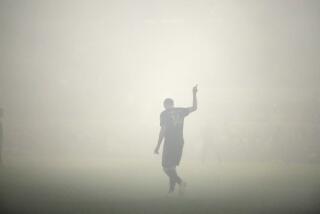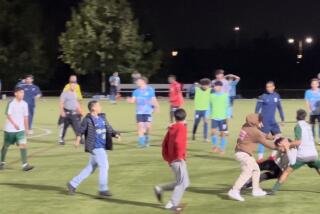From the archives: Police, Stadium Blamed in British Soccer Deaths
SHEFFIELD, England -- Poor police crowd control, inadequate emergency medical facilities and shortsighted design of the soccer stadium here were being blamed Sunday as the death toll rose to 94 in the nation’s worst sports disaster.
The victims were asphyxiated or crushed to death at a national soccer championship playoff match Saturday when thousands of additional spectators surged at the last minute into an enclosed and already overcrowded viewing terrace, trapping early arrivals against fixed metal barriers.
A clearly shaken Prime Minister Margaret Thatcher announced a full-scale public inquiry into the disaster during a four-hour visit Sunday to the site of the tragedy and to some of the 50 injured fans still in the hospital. In all, more than 200 were injured.
“Whatever decisions we have to take will be taken, because we cannot go through this again,” Thatcher said during a half-hour tour of Sheffield’s Hillsborough Stadium, where Saturday’s semi-final championship contest between Liverpool and Nottingham Forest turned into a nightmare of panic and agonizing death.
After hearing several survivors tell of the event, Thatcher described their experiences as “a story, in the midst of tragedy, of tremendous, heroic courage and, of course, still fantastic anxiety.”
Hero schoolboy Ian Clarke, 16, told Thatcher how he used the life-saving techniques he learned as a swimmer to give mouth-to-mouth resuscitation to “10 or 12” victims before collapsing himself.
“As the crowd moved away I could see people lying there with their faces going purple, so I helped drag them away,” Clarke said. “We got about eight of them back alive, but I’m not sure about the others.
“I went back to get a few more from the terracing, but there was another surge and I was knocked on the ground. It was like being underwater when you can’t get back up and you’ve got no air. I was trying to fight, but there were dead bodies on top of me.
“The only way I can describe it--it was like something out of a horror movie.”
In a country suffused with grief and anger after the tragedy, the inquiry is considered likely to bring legislation that could drastically alter the traditional face of Britain’s most popular sport.
10,000 Mourners at Service
At Liverpool, the blue-collar port city that was home to most of the victims, up to 10,000 mourners attended a memorial service Sunday evening. Three thousand filled Liverpool’s huge concrete and glass Roman Catholic cathedral, while more than twice that many stood outside under chilly, overcast skies.
The first 25 fatal victims identified by police Sunday ranged in age from 10 to 62 and included two sisters, aged 15 and 19. Most of the dead were young men.
London’s Sunday Times and Sunday Telegraph both published extraordinary, angry front page editorials about the tragedy.
“A slum sport played in slum conditions,” railed the Sunday Times. “Despite disaster after disaster, nothing seems to shake the complacency or incompetence of those who run the country’s most popular spectator sport. Football (soccer) stadiums and their administration remain a disgrace. They are filthy, dangerous places; spectators only put up with them because of their enthusiasm for what happens on the pitch (field).”
“Pitiful indeed is the country that cannot ensure the safety of its people while at play,” declared the Sunday Telegraph. “Inquiries are set up after each successive tragedy. New precautions are decreed. But to no avail. Football calamities are becoming as much a natural part of Britain’s fate as are earthquakes in South America or famine in India.”
The Football Assn., which administers professional soccer in Britain, is to decide early this week whether to cancel the rest of this year’s national championship playoffs--a move comparable to halting the Super Bowl in the United States.
Saturday’s tragedy also raised new questions over a ban that prevents British clubs from participating in European competition. The sanction was imposed after British fans attacked their Italian rivals during a May, 1985, match at Heysel Stadium in Brussels, Belgium, triggering a riot in which 39 people died.
The Union of European Football Assns., which is the ruling body of European soccer, voted only last week to lift the ban for the 1990-91 season. But its action was conditional on the continued good conduct of British fans and the agreement of the British government.
While there was no Heysel-type hooliganism in Sheffield on Saturday, the incident is nevertheless bound to raise more questions internationally about the behavior of British soccer fans.
Here, however, it was the police who appeared to be getting most of the blame on Sunday. South Yorkshire County Police Constable Peter Wright has confirmed that a senior police official at the scene ordered a 16-foot-wide gate to be opened at the back of the grandstand just minutes before game time Saturday.
Most survivors say it was that action that produced the last-minute surge of fans into the ground-level, standing-room-only spectator terrace behind the goal at Liverpool’s end of the stadium.
‘Life-Threatening Situation’
Police said the decision was made to relieve what they called a “life-threatening” situation that was developing outside the stadium as crowds of frustrated fans, unable to gain admittance, surged against closed turnstiles.
The police are also accused by some critics of losing control both outside the stadium and inside, where the last-minute surge of entrants was allowed to jam the already crowded center sections of the Liverpool end zone rather than being funneled into two less crowded sections on either side.
The tension among the police was clear here Sunday when a senior officer waved off reporters’ questions and walked abruptly out of a press conference after announcing that there is also to be an internal police inquiry into the actions of his forces.
Dr. John Ashton, a professor of medicine at Liverpool University, charged that once the incident occurred, “there was no organized (medical) response at all. There was nobody in charge, no plan, no organization at all. I had to make sure the people who were still alive and most seriously injured were got off to hospital first.”
Ashton described the scene as “absolute chaos” and complained that there was no resuscitation equipment available on the spot.
‘Appalling ... Disgrace’
Dr. Glyn Phillips, another practitioner who rushed onto the field to help the injured, said he asked for an electric shock machine at one point and was told there was none at the stadium. Later, he was given an oxygen tank that turned out to be empty. He called the situation “appalling” and “an absolute disgrace.”
Criticisms of stadium design are potentially the most significant in the long run, raising the possibility of fundamental change in spectators’ habits here.
Hillsborough’s perimeter fence, for example, originally installed between the stands and the playing field to cut down on crowd violence and prevent rowdy fans from disrupting play, turned into a death cage Saturday, preventing crushed fans from using what would have been their only avenue of escape.
The fence was installed at the insistence of local police and over the protest of the Sheffield club’s safety consultant, Dr. Bill Eastwood. Similar fences are used in the stadiums of most top professional clubs.
“Perimeter fencing has been the product of an obsession with hooliganism as distinct from concern with safety,” said Roy Hattersley, the opposition Labor Party’s shadow home secretary. “Yesterday I think we saw the ending of perimeter fencing and the terrible things that happen when pressure becomes unbearable,” the politician said in a British Broadcasting Corp. television interview Sunday.
Spectators’ Habits
There were also calls to replace standing-room-only spectator terraces with regular seats, a move that would drastically reduce the capacity of the country’s soccer grounds and radically alter spectators’ habits spanning generations.
Many British fans have historically preferred to watch their favorite soccer team while standing shoulder-to-shoulder on huge, open concrete terraces behind the goal and swaying to home-team chants. Even at Hillsborough, which is considered one of the most up-to-date stadiums, nearly 60% of the listed capacity is made up of standing-only terraces.
To someone more used to American football stadiums, these terraces are claustrophobic affairs even under normal circumstances. And as Saturday proved, they can be deadly in abnormal ones.
“There has to be a fundamental re-think about this issue,” said Football Assn. chief executive Graham Kelly at a London press conference Sunday. “We have got to get our football clubs to get to their supporters and say: Are you sure that in this day and age, you want to go through turnstiles and a tunnel and stand in a place like that?”
Kelly added that Britain would not have “a cat in hell’s chance” of hosting a future World Cup soccer competition without stadiums in which all spectators had seats.
However, Jill Smith, an administrator for the English Football Assn., said “clubs have tried to change the way fans watch matches by eliminating terraces and making their stadiums all-seating. But the public in England demands the right to stand.”
More to Read
Start your day right
Sign up for Essential California for news, features and recommendations from the L.A. Times and beyond in your inbox six days a week.
You may occasionally receive promotional content from the Los Angeles Times.






